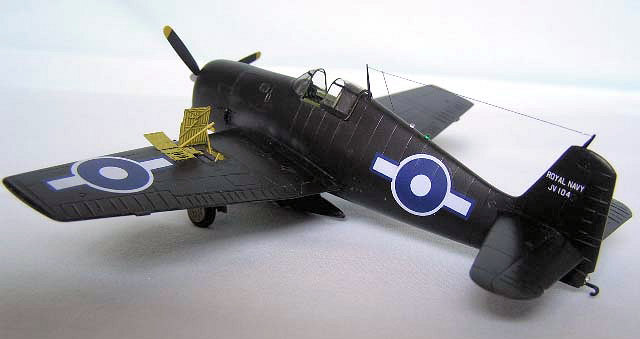
| KIT #: | 2121 |
| PRICE: | £2.98 |
| DECALS: | Two options |
| REVIEWER: | Fernando Rolandelli |
| NOTES: |

| HISTORY |
Notes about Hellcat’s history would be almost as superfluous as about 109’s, and their incredible kill-loss ratio well known. In Royal Navy’s Fleet Air Arm they started to get into action from Operation “Dragoon” (the invasion of the South of France) onwards (excluding some early service in the spotter role during the D-Day, by 800 Sqn aboard HMS Emperor, which took them to Norway and the Mediterranean), usually sharing escort and flak-busting tasks with Martlet/Wildcats and Corsairs, while Seafires acted as CAPs over the Fleet.
In the East Hellcats and Corsairs were employed in offensive operations by both the Eastern Fleet/East Indies Fleet and the British Pacific Fleet later, until the end, having their share of victories in the rare occasions in which there was any air combat. Though the Hellcats were considered safer and more reassuring to the average pilot, there are some reports implying that Corsairs were preferred to the Grumman’s (for instance, Royal Marines’ ace Ronnie Hay), and in fact HMS Indomitable was the only Fleet carrier in the BPF to embark Hellcats, those in 1839 and 1844 Sqns, most of them were embarked on CVEs serving in the Fleet train.
MAM reports that during a spell of no-flying due to bad weather conditions, Sub Lt Campbell and his crew asked for and received permission to repaint JV104 in Gloss Black. This finish improved considerable cruise performance and fuel consumption.
| THE KIT |
Academy’s Hellcat is a good kit, simple and a bit thick on small details, but generally accurate and well-behaved. The fin/rudder profile is completely wrong at the top, but this can be fixed. The partitions of the cowling front intake are not in a completely accurate position/angle. Interior detail is scarce and inaccurate, so an aftermarket set or some scratchbuilding are mandatory, but that’s the norm in 1/72nd scale kits. Wheel wells should be boxed to some extent, and a vacuform canopy is advised. Decals are not great, but usable. But that’s it, and you should be left with a fairly good looking F6F.
 I felt the kit “as is” was a bit
undistinguished, so I decided early to throw a complete detailing set by
Verlinden. This included interior parts in resin and PE, a complete gun bay in
PE (guns in resin) and a ventral tank. To show the interior parts, a Squadron
vac canopy was added for good measure.
I felt the kit “as is” was a bit
undistinguished, so I decided early to throw a complete detailing set by
Verlinden. This included interior parts in resin and PE, a complete gun bay in
PE (guns in resin) and a ventral tank. To show the interior parts, a Squadron
vac canopy was added for good measure.
Very soon I realized the idea of the Verlinden set was a mistake. The interior pieces were far too big, to the point of being unusable; the instrument panel included the pedestal console, which should be separate. The PE parts were of the thickness of armor plate and almost as pliable. The gun butts were very bulky and overscale. All in all, a set to be avoided, exception made for the PE parts for closing the wheel wells, which, nevertheless were very difficult to get fit. Weird that the D&S book warmly recommends it.
After all this frustration, I resorted to an Aires interior set. Man, this is all what you expect from such a set. The sidewalls and floor are correct, and the instrument panel fits as a glove. The seat is still somewhat poor, but passable; the only option would have been a folding PE seat.
| CONSTRUCTION |
Cockpit
 Taking due care, sidewalls fit
really well, and the floor/bulkhead combo snaps fit. The usually scary
instrument panel can be safely attached to the fuselage half you have chosen as
your working one. I added some wiring and some levers to the console. After some
deliberation, I painted the cockpit Interior Green (FS 34151); some sources
state it being Bronze Green, others maintain that only the first 100 F6F-3 had
the latter. Levers, buttons and other detail were painted as per my references.
Taking due care, sidewalls fit
really well, and the floor/bulkhead combo snaps fit. The usually scary
instrument panel can be safely attached to the fuselage half you have chosen as
your working one. I added some wiring and some levers to the console. After some
deliberation, I painted the cockpit Interior Green (FS 34151); some sources
state it being Bronze Green, others maintain that only the first 100 F6F-3 had
the latter. Levers, buttons and other detail were painted as per my references.
Airframe
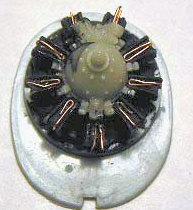 The front engine cylinder row
was another addition from the Verlinden set, but, if you are willing to
scratchbuild the two magnetos out of some plastic rod, there is little to choose
comparing it to the kit’s. The set also provides the cowling flaps but I was
through with the whole set and did not even consider the idea. The interior of
the cowling was painted FS 36440, mimicking Grumman Grey. The kit’s rear view
windows were used, and fixed before the fuselage halves were glued together;
some sanding and polishing from the outside was necessary. I usually replace the
hood by a vacuformed piece, but keep the windshield, but in this case I decided
to have a go with the vac one, which looked much more to scale, and it fitted
very well with minimal fuss. I dropped the idea of adding the internal bullet
proof windscreen.
The front engine cylinder row
was another addition from the Verlinden set, but, if you are willing to
scratchbuild the two magnetos out of some plastic rod, there is little to choose
comparing it to the kit’s. The set also provides the cowling flaps but I was
through with the whole set and did not even consider the idea. The interior of
the cowling was painted FS 36440, mimicking Grumman Grey. The kit’s rear view
windows were used, and fixed before the fuselage halves were glued together;
some sanding and polishing from the outside was necessary. I usually replace the
hood by a vacuformed piece, but keep the windshield, but in this case I decided
to have a go with the vac one, which looked much more to scale, and it fitted
very well with minimal fuss. I dropped the idea of adding the internal bullet
proof windscreen.
The
Verlinden set provides a part to address the problems in the top of the fin
contour, but I was by that time completely disillusioned about it and just built
up the area with a small plastic edge and cyano,
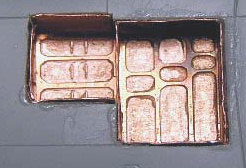 adding bit by bit and sanding to
shape. Rudder can be fixed just by sanding.
adding bit by bit and sanding to
shape. Rudder can be fixed just by sanding.
In the
wings, I used the provided wheel well blanking PE part, which conformed to the
well’s contours after much persuasion (these Bronze Age PE parts…) as well as
the provided hook for the leg. The wells, doors and legs were painted Sky Type
S; the ones in American planes were usually painted the underside color. I had
already drilled the hole for the gun bay, so it had to go, but I had a pretty
rough time to have it fit. The bay and the doors themselves are okay, but the
guns are too big and the ammo boxes’ lids seem to have been patterned after the
ones in the mixed battery -3N. Anyway, the ammo belts provided do not reach the
breeches, so a somewhat untidy (and utterly inaccurate) extension had to be
made. The “spider lock” was added
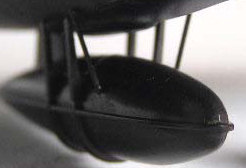 to the main lid (the mechanism a
PE part
to the main lid (the mechanism a
PE part 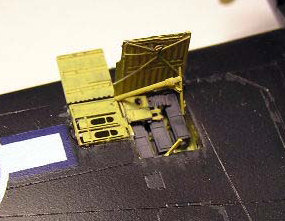 and the braces stretched
sprue) and it looks great. The bay was painted YZC, masked and the bits and
pieces were added at the last moment. I have no idea of how the mechanism to
lock the lid works (other than the spider lock), but the “brace to nowhere” is
very prominent in pictures, so I added it.
and the braces stretched
sprue) and it looks great. The bay was painted YZC, masked and the bits and
pieces were added at the last moment. I have no idea of how the mechanism to
lock the lid works (other than the spider lock), but the “brace to nowhere” is
very prominent in pictures, so I added it.
Gun tubes protrude too much and were therefore trimmed, and the undercarriage received some hydraulic lines. Rockets are not carried and I left the bomb racks out. I had planned to install the Verlinden drop tank, but in the event I went for the one in the kit, thinning out the braces and providing the front ones which were not included.
| COLORS AND MARKINGS |
Well, I had bought SAMI’s generic BPF decal sheet, so I was eager to give them a go. I also wanted to take the opportunity of modeling JV104 in 1/72nd, as I consider that the mass of a 1/48th Hellcat in Black would be too disturbing.
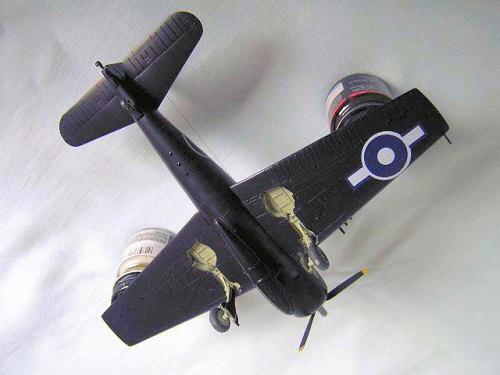 Painting was achieved in several
sessions, using Xtracrylix paints. I primed everything with Alclad Grey Primer
and started “preshading” over the panel lines, then filling up “mottle fashion”
the inside of the panels. How do you provide “interest” (nuances in color from
panel to panel) in an overall Black aircraft? I mean, actually painting it Black
and not some sort of dark grey; adding to that, Black always looks too bluish
when mixed with any amount of White or Light Grey. All this without overdoing
the effect in 1/72nd, and considering this was, if not exactly a VIP
machine, one obviously well cared for (both pilot and crew would want to make
their point in repainting the aircraft, and it should have been kept clean and
glossy for that) Nuances were obtained by further “mottling” with Black mixed
with a little Red (much of it and it turns a muddy Brown) but no “masked effect”
was done because it would have been too harsh. Wheel wells, legs and the insides
of doors were kept in the original Sky Type S, this having originally been a
Temperate Sea Scheme painted machine. Exhaust stains were made by mixing Black
with Dark Earth, which provides a nice, warm grey. Instead of chipping, very
unlikely in this machine, I painted small patches of a strong Clear Flat (I used
Aeromaster’s), which alters the Gloss Black to incredible levels, to the point
that you very easily overdo the effect (I mixed some Xtracrylix Flat in it –this
one is very satin-like)
Painting was achieved in several
sessions, using Xtracrylix paints. I primed everything with Alclad Grey Primer
and started “preshading” over the panel lines, then filling up “mottle fashion”
the inside of the panels. How do you provide “interest” (nuances in color from
panel to panel) in an overall Black aircraft? I mean, actually painting it Black
and not some sort of dark grey; adding to that, Black always looks too bluish
when mixed with any amount of White or Light Grey. All this without overdoing
the effect in 1/72nd, and considering this was, if not exactly a VIP
machine, one obviously well cared for (both pilot and crew would want to make
their point in repainting the aircraft, and it should have been kept clean and
glossy for that) Nuances were obtained by further “mottling” with Black mixed
with a little Red (much of it and it turns a muddy Brown) but no “masked effect”
was done because it would have been too harsh. Wheel wells, legs and the insides
of doors were kept in the original Sky Type S, this having originally been a
Temperate Sea Scheme painted machine. Exhaust stains were made by mixing Black
with Dark Earth, which provides a nice, warm grey. Instead of chipping, very
unlikely in this machine, I painted small patches of a strong Clear Flat (I used
Aeromaster’s), which alters the Gloss Black to incredible levels, to the point
that you very easily overdo the effect (I mixed some Xtracrylix Flat in it –this
one is very satin-like)
Decals would be pretty straightforward, but for the need of “composing” the serial number from extremely small (4 scale inches) individual numbers. Insignia should, also, but agreeing on the exact size was problematical. I settled over 48 inches on wings and 40 inches on the fuselage (48 inches insignia were recommended overall, but I have seen a picture of JV104 and the fuselage ones did not seem so imposing) Over a nice glossy clear cote, they performed flawlessly. The Roundel Blue is just a bit misaligned; I had to cut a thin strip of White protruding one of the bars.
| CONCLUSIONS |
This was a nice “short-term” project. In the end, it came up to an interesting model without the need of the open gun bay, which was the source of most of the trouble. The Aires set works wonderfully; I have seldom seen a PE instrument panel fit like that. I was also impressed with the fit of the Squadron windscreen. The SAMI decals are also very good, though the way they are issued you will run out of insignias much before your code and serial numbers are used up; I think a second sheet of the former would be a nice idea.
| REFERENCES |
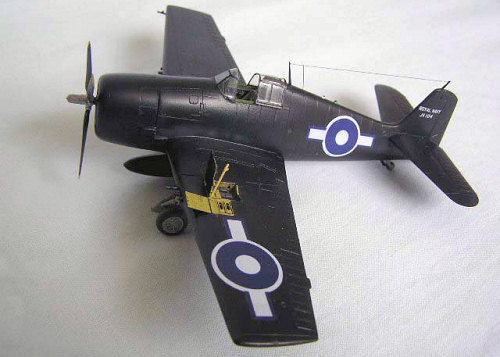 -
“VJ-Special British Pacific Fleet”, Model Aircraft
Monthly Vol. 4 Iss 8 and 9, August and September, 2005.
-
“VJ-Special British Pacific Fleet”, Model Aircraft
Monthly Vol. 4 Iss 8 and 9, August and September, 2005.
- “Fleet Air Arm. British Carrier Aviation 1939-1945”, Ron Mackay, Squadron Signal Publications.
- “Britain’s Fleet Air Arm In World War II”, Ron Mackay, Schiffer Military History Books
- “British Naval Aviation. The Fleet Air Arm, 1917-1990”, Ray Sturtivant, Naval Institute Press.
July 2007
Copyright ModelingMadness.com. All rights reserved. No reproduction in part or in whole without express permission.
If you would like your product reviewed fairly and fairly quickly, please contact the editor or see other details in the Note to Contributors.
Back to the Review Index Page 2023